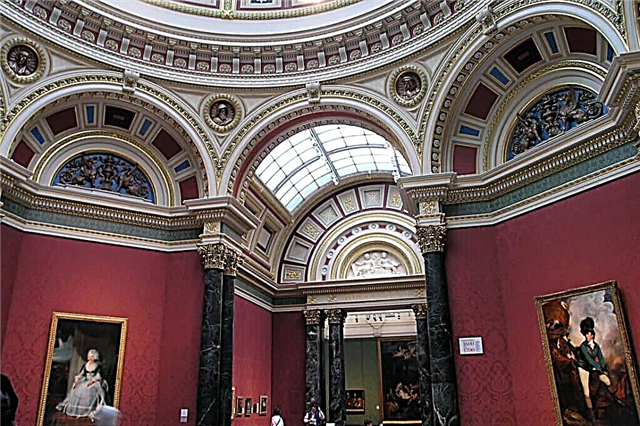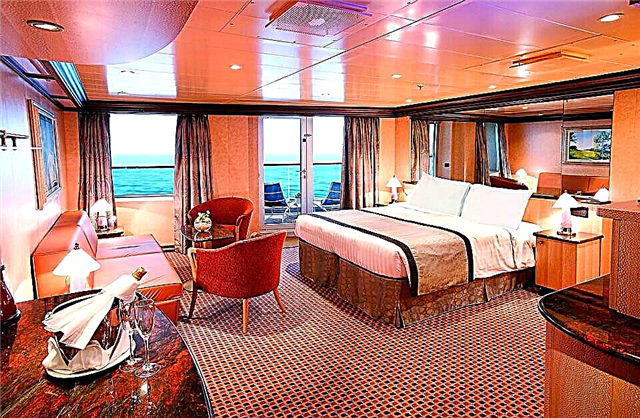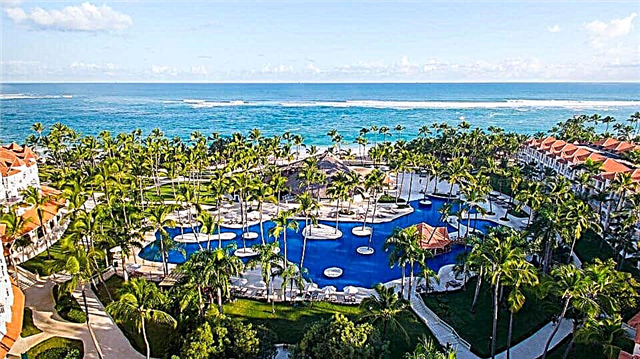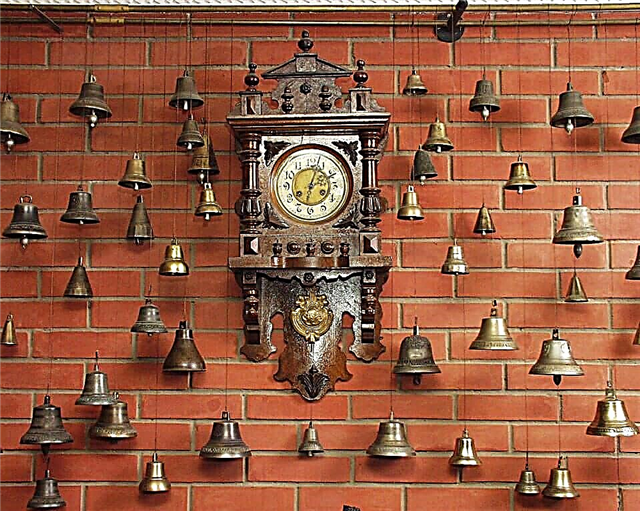One of the most famous repositories of paintings, the London National Gallery, is evidence of the responsible attitude of the state and the powers that be to the cultural and aesthetic development of society. The history of the creation of an art gallery located on Trafalgar Square. the English capital, reliably confirms this.
History
In 1824, the government of England acquired 38 paintings from the collection of the banker Angerstein (a native of Russia), which served as the first impetus for organizing the future gallery. Almost all of the acquired art canvases are masterpieces by Rubens, Titian, Piombo, Reynolds and other brilliant painters of the 13th-16th centuries.
At first, the paintings were exhibited on the street. Pall Mall, in a small house, but when in 1831 the number of paintings reached 114, the government decided to build a new museum building on Trafalgar Square. For this purpose, the remains of the former royal stable were used, from which the architect Wilkins preserved 8 magnificent columns.
The grand opening of the pompous building of the gallery took place in 1836. Lords, barons, artists bequeathed their collections to the opened gallery, which over time was supplemented with new halls. Now in the premises of the gallery 2.3 thousand classical samples of painting from Western Europe are exhibited, arranged in chronological order.

In the new building, added in 1991 (wing of Sainsbury), there are works of early creativity (1260-1510), in the northern part there are paintings of the middle stage (1510-1600). Paintings from the 17th century are displayed in the western halls, and canvases from the 18th to early 20th centuries are displayed in the eastern halls.
Every year the gallery's funds expanded, requiring additional space, so the building was rebuilt and expanded several times due to additional wings. The last one was built (1991) at the expense of the trade magnate Simon Sainsbury and is named after him. The royal family took an active part in the creation of the new wing, rejecting the original design of the new extension and inviting another architect for this purpose.
The National Gallery of London ranks 3rd in the world in terms of attendance, being an independent non-governmental organization. However, members of the governing council are appointed by the prime minister of the country, and the government provides annual grants for the maintenance of the gallery.

The area of the gallery is now equal to the area of 6 football stadiums, but instead of football battles, a field of aesthetic pleasure and boundless admiration for the enduring art of painting unfolds here. From hall to hall, this feeling accompanies visitors, fascinated by the contemplation of masterpieces.
Halls
The National Gallery of London is a repository of showrooms that form a kind of labyrinth in which it is easy to get confused. To avoid this, you should buy a gallery plan at the entrance or download it from the museum's website in advance. Walking through all the halls of the gallery, you can get acquainted with the paintings of almost all European countries, including Great Britain, from the 13th to the beginning of the 20th century.

The hall of Venetian painting is represented by the masterpieces of the great masters: Bellini, Mantegna, Conegliano, Messina and other talented artists. In the museum's storerooms, there is a canvas by early Giorgione (the greatest artist of the Renaissance), which is rarely displayed, because experts are not yet fully confident in its authenticity.
The Hall of Spanish Painting is inferior to the Prado Museum in terms of the number of masterpieces, but it can be proud of the largest collection of Velazquez's works, including his famous canvas (the only one with a nude) "Venus with a Mirror".
A separate room displays paintings from the "golden age" of the Dutch art school - the genius Rembrandt, whose canvases reflect the life of the greatest creator. The portraits, stunning with the skill of the artistic image, depict the images of his 2 wives, friends and associates, the artist's self-portrait.

In the room dedicated to another Dutch genius of drawing, Rubens, there are 24 paintings, mostly created by him in the last years of his life as a true creator from God. They fully reveal the mature talent of a free artist who writes at the behest of his soul for his own pleasure. There are in the gallery works of the school of “small Dutchmen” collected by the true enthusiasts of the museum: Gerard Terborch, Peter de Hoch, Jacob van Ruisdael, A. van Ostade.
Painting of France in all its manifestations is presented in an unusually wide and varied manner. Paintings by Poussin and Lorrain reflecting the academic style; realistic canvases by the Lenin brothers, portraits of statesmen by Champaigne (Cardinal Richelieu) and Rigaud (Louis XIV) captivate with the skill of the image. Fans of the "Barbizon" partnership are delighted with landscapes by Corot and Daubigny, picturesque portraits by Delacroix, Courbet, David and Ingres.
Delight is aroused by the artistic masterpieces of the so-called "gallant painting" of the 18th century. She is represented by paintings by Watteau, filled with sweet sadness; Fragonard, drawing heroes of mythological plots. It is impossible to tear yourself away from the paintings of Chardin, conquering outwardly with their ordinarily sweet simplicity and democratic plots. Greuze's paintings delight with a gentle depiction of "airy young ladies", evoking nostalgia for bygone times.

The Hall of French Impressionists, which continues to be replenished with gifts from private owners, shows rare paintings by Monet, Renoir, Pissarro, Manet, Sisley.
The halls of British art with the works presented in them reflect the variety of genres of English painting, all the nuances of the wonderful nature of the island state. Paintings by Stubbson, an artist and a passionate fan of horses, depict them in various angles, poses and colors. The amazingly beautiful landscapes of Constable's hometown penetrate the soul with their discreet tones and semitones.
In the Hall of English Portrait, the highly artistic canvases of the royal court portrait painters Van Dyck, the founder of the English portrait genre, and Holbein, who painted many portraits of representatives of the royal family, are impressive. The ceremonial portraits of other nobles, made by Lawrence, captivate with subtle realism.

The National Gallery of London has world famous masterpieces of painting such as "Sunflowers" by Van Gogh, "Holy Family" by Titian, "Landscape with the Castle of the Walls" and others. The names of art masterpieces alone are evidence of the invaluable cultural significance of the National Gallery not only for England, but for the whole world.
In addition to the exhibition halls, the gallery has a lecture hall and a reference room with computer equipment for visitors, where they can outline in advance a plan for the upcoming voyage through the gallery's “labyrinths”.
Replenishment and development of collections
An important contribution to the prosperity of the National Gallery was made by its first director, artist, art critic and art connoisseur Charles Eastlake. For 10 years in this position, Eastlake personally took part in the replenishment of the museum's exhibits, acquiring unsurpassed artistic masterpieces from renowned European collectors.

He and his assistants visited many European cities, ancient monasteries, ancient rural churches, met with famous collectors and artists. Among the 139 paintings he bought, there are truly unique paintings by the Florentine master of the Early Renaissance Paolo Uccello "The Battle of San Romano" and Bellini's "Madonna of the Meadow". Every year the museum funds were replenished at the expense of paintings donated by patrons of the arts.
For example, collectors George Beaumont and Holwell Carr donated their collections of paintings by Rubens, Canaletto, Tintoretto, Rembrandt.The collection of Italian painting was enriched with masterpieces by artists of the Early Renaissance (14-15th century): the Dominican monk Fra Angelico; the founder of the Italian Quattrocento A. Pisanello and the Florentine painter, Botticelli's teacher - Filippo Lippi, donated to the museum by private traders.
Queen Elizabeth also made a significant contribution to the National Galleri Foundation during the opening of the Sainsbury wing (1991), donating 100 unique paintings by Vermeer, Rubens, Holbein, Van Dyck and others to the museum, shown at the special exhibition Queen's Paintings.
To this day, the collection of the National Gallery (Salisbury wing) is expanding, more recently it has been adorned with priceless canvases of Gothic painting by Bermejo, the German classic Dürer, the French post-impressionist Seurat, the Bavarian landscape painter Altdorfer.
Coca-Cola London Eye Ticket - £ 24.30
Tower of London and Royal Treasure Exhibition Ticket - £ 26.80
Tower Bridge Ticket - £ 9.80
Westminster Abbey entrance ticket and audio guide - £ 20
Madame Tussauds ticket - £ 29
St Paul's Cathedral Fast Track Ticket - £ 16
Skyscraper "Shard" - entrance ticket and champagne - £ 24.95
Opening hours and how to get there

Address: London, Trafalgar Square, National Gallery.
Visiting hours: every day, from 10.00 to 18.00, Friday - from 10.00 to 21.00.
The entrance is free.
We recommend the following hotels in London:
Central Park Hotel
London
Located less than 100 meters from Hyde Park

Hotel Edward Paddington
London
Minutes from Paddington Station and Hyde Park

DoubleTree by Hilton London - Docklands Riverside
London
Located on the embankment of the Thames

Park Plaza County Hall London
London
Just minutes from the banks of the Thames and the London Eye












